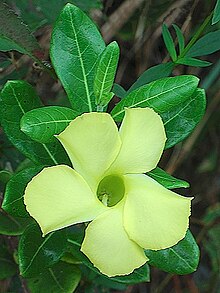
Bauhinia is a large genus of flowering plants in the subfamily Cercidoideae and tribe Bauhinieae, in the large flowering plant family Fabaceae, with a pantropical distribution. The genus was named after the Bauhin brothers Gaspard and Johann, Swiss-French botanists.
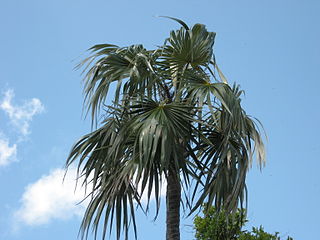
Coccothrinax argentata, commonly called the Florida silver palm, is a species of palm tree. It is native to south Florida, southeast Mexico, Colombia and to the West Indies, where it is found in the Bahamas, the southwest Caribbean and the Turks and Caicos Islands. Its natural habitat is rocky, calcareous soil in coastal scrubland and hammock communities.
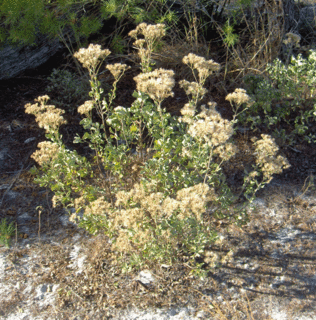
Garberia is a monotypic genus of flowering plants in the aster family, Asteraceae, containing the single species Garberia heterophylla. It is endemic to Florida in the United States, where it is distributed in the northern and central counties. The plant is known commonly as garberia and Garber's scrub starts.
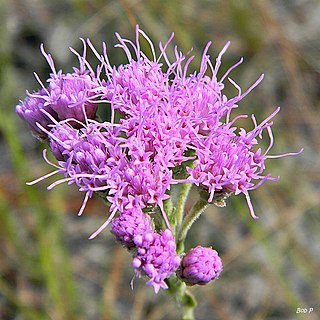
Carphephorus is a genus of North American plants in the sunflower family. They are native to the southeastern United States from Louisiana to Virginia. Plants of this genus are known commonly as chaffheads.

Sideroxylon celastrinum is a species of flowering plant in the family Sapotaceae, that is native to Texas and Florida in the United States south through Central America to northern Venezuela and Colombia in South America. Common names include saffron plum and coma. It is a spiny shrub or small tree that reaches a height of 2–9 m (6.6–29.5 ft). The dark green leaves are alternate or fascicled at the nodes and oblanceolate to obovate. Greenish-white flowers are present from May to November and are followed by single-seeded, blue-black drupes.

Urochloa is a genus of plants in the grass family, native to Eurasia, Africa, Australia, Mexico, and the Pacific Islands. Common names include signalgrass.

Christella normalis, synonym Thelypteris kunthii, sometimes known as Kunth's maiden fern or southern shield fern, is the most common of the maiden ferns in the southeastern United States south of the fall line. It ranges westward to eastern Texas. It usually grows in moist to dry terrestrial situations, but can also be epipetric. It often grows as a greenhouse escape in areas north of its usual range.

Butia capitata, also known as jelly palm, is a Butia palm native to the states of Minas Gerais and Goiás in Brazil. It is known locally as coquinho-azedo or butiá in (northern) Minas Gerais. This palm grows up to 8m. It has feather palm pinnate leaves that arch inwards towards a thick stout trunk.

Vitis palmata is a New World species of tall, climbing liana in the grape family native to the south-central and southeastern parts of the United States, from Texas east to Florida and northwards along the Mississippi Valley to Illinois. There are additional reports of isolated populations in the Northeast, but these are probably introductions.) The species does best in wet habitats but is adaptable enough to occasionally take root in higher-ground habitats. It is sometimes found at the edges of fences.
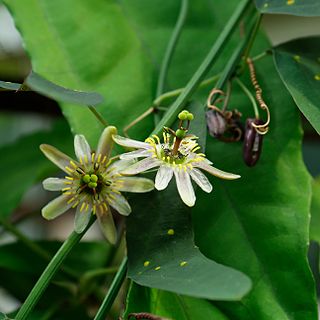
Passiflora biflora, the twoflowered passionflower, is a vine with paired peduncles and flowers up to 3.5 cm (1.4 in) wide. It is native to the New World from Mexico to Colombia and Venezuela. In Florida, P. biflora has been classified by the Exotic Pest Plant Council as a non-native species that has the "potential to disrupt native plant communities."

Polyscias guilfoylei, the geranium aralia or wild coffee, is a species of evergreen shrub native to the paleotropics and neotropics. It is not closely related to the true coffee plants of the genus Coffea. It has erect branches and can grow to a height of up to 24 ft (7.3 m). The leaves are long and 1-pinnate with leaflets which are opposite. The leaf blades are variable, but usually ovate or elliptic and coarsely dentate or lacerate. The leaves are commonly variegated with margins of white or pale yellow, but can also be entirely dark green.

Campyloneurum phyllitidis, commonly known as the long strap fern, is a species of fern in the family Polypodiaceae.

Agave weberi, known as maguey liso in Spanish and as Weber agave in English, is a succulent perennial plant in the family Asparagaceae, subfamily Agavoideae. Under the synonym Agave neglecta, it is known as wild century plant and Small agave – the latter in honor of its discoverer in Florida, John Kunkel Small. Naturalized populations in Florida were considered to be a separate species, but are now treated as synonymous with A. weberi.

Smilax auriculata, is a North American plant species native to the Bahamas, the Turks & Caicos Islands, and the southeastern United States. Common names include earleaf greenbrier and wild-bamboo, despite the fact that it is not closely related to bamboo. It is reported from Florida, Georgia, North and South Carolina, Alabama, Mississippi, and Louisiana. It grows on coastal sand dunes and in sun-lit locations in sandy woodlands at elevations of less than 100 m.

Ficus altissima, commonly known as the council tree and lofty fig, is a species of flowering plant, a fig tree in the family Moraceae. It is a large, stately evergreen hemiepiphyte and is native to southeastern Asia.

Rhabdadenia is a genus of plant in the family Apocynaceae first described as a genus in 1860. It is native to South America, Central America, southern Mexico, the West Indies, and Florida.
- Rhabdadenia barbata(Desv. ex Ham.) Miers = Pentalinon luteum(L.) B.F.Hansen & Wunderlin
- Rhabdadenia berteroi(A.DC.) Müll.Arg. = Angadenia berteroi(A.DC.) Miers
- Rhabdadenia campestris(Vell.) Miers = Mandevilla hirsuta(Rich.) K.Schum.
- Rhabdadenia corallicolaSmall = Angadenia berteroi(A.DC.) Miers
- Rhabdadenia cubensisMüll.Arg. = Angadenia berteroi(A.DC.) Miers
- Rhabdadenia laxifloraMiers = Pentalinon luteum(L.) B.F.Hansen & Wunderlin
- Rhabdadenia lindenianaMüll.Arg. = Angadenia lindeniana(Müll.Arg.) Miers
- Rhabdadenia lucidaMiers = Odontadenia nitida(Vahl) Müll.Arg.
- Rhabdadenia polyneuraUrb = Odontadenia polyneura(Urb.) Woodson
- Rhabdadenia sagrae(A.DC.) Müll.Arg. ex Griseb. = Angadenia berteroi(A.DC.) Miers
- Rhabdadenia wrightianaMüll.Arg. = Neobracea valenzuelana(A.Rich.) Urb.
Angadenia is a genus of plants in the family Apocynaceae first described as a genus in 1878. It is native to Florida and the West Indies.
- Angadenia berteroi(A.DC.) Miers - Florida, Bahamas, Cuba, Hispaniola, Turks & Caicos Islands
- Angadenia lindeniana(Müll.Arg.) Miers - Cuba, Hispaniola, Jamaica
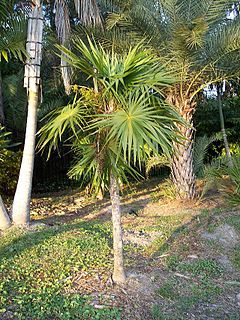
Thrinax radiata, the Florida thatch palm, is a medium to slow growing palm in the family Arecaceae. It is native to many Caribbean islands, Central America, and far southern Florida. Its natural habitat is sandy, calcareous soil in coastal areas.
Carphephorus odoratissimus, common name vanillaleaf, is a species of North American plants in the sunflower family. This species is native to the southeastern United States, including the states of Georgia, North Carolina, South Carolina, Alabama, Mississippi, Louisiana, and Florida.
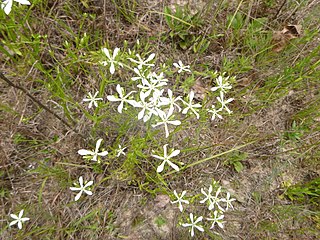
Sabatia quadrangula, the fourangle rose gentian or four-angle rose-gentian, is a flowering plant native to the eastern United States. It is found in pine savannas, flatwoods, shrub bog borders, ditches, and granite outcrops from Virginia south to the Florida panhandle and west to Alabama.
